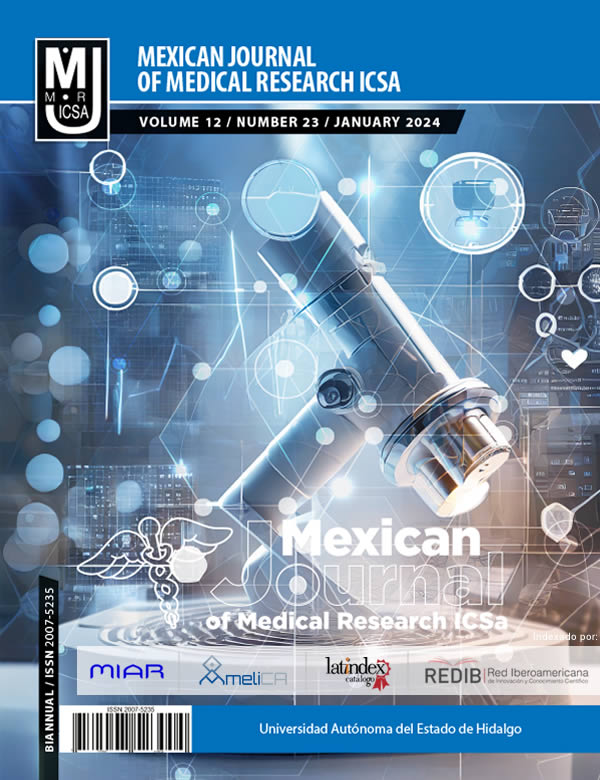Development of dyslipidemias in a cohort of Mexican adult patients with HIV/AIDS under highly active antiretroviral therapy
DOI:
https://doi.org/10.29057/mjmr.v12i23.11518Keywords:
Dyslipidemias, highly active antiretroviral therapy, HIV infections, acquired immunodeficiency syndromeAbstract
Dyslipidemias are comorbidities in seropositive patients under highly active antiretroviral therapy (HAART), which increase their risk of complications and reduce their life expectancy. Objective: evaluate the frequency and development of dyslipidemias in seropositive patients with highly active antiretroviral therapy (HAART). Material and method: retrospective cohort study, in recently diagnosed HIV+ patients: 366 men and 59 women. Serum concentrations of total cholesterol (TC), triglycerides (TGC), HDL cholesterol (HDL-c) and LDL cholesterol (LDL-c) were evaluated before starting and at month 6, 24, 36 and 48 with HAART. Results: in both sexes at the beginning of the HAART, 67.1% of low HDL-C levels were obtained. Dyslipidaemia due to TGC and TC increased significantly in all participants after 48 months of HAART (36.9% vs. 52.7% and 7.1% vs. 22.4%, respectively, p<0.05). however, the HDL-C decreased in patients with nucleoside and non-nucleoside reverse transcriptase inhibitor drugs. Discussion: HIV+ patients with HAART have a higher risk of developing dyslipidaemia, an increase in concentrations occurred after 6 months of treatment, a trend that continued positive until 48 months with HAART. Conclusions: dyslipidemias due to TG and TC, as well as low HDL-C are the most frequent in HIV+ patients, which change depending on the time and the type of drug indicated in the HAART.
Downloads
Publication Facts
Reviewer profiles N/A
Author statements
- Academic society
- N/A
- Publisher
- Universidad Autónoma del Estado de Hidalgo
References
Hammer SM, Squires KE, Hughes MD, Grimes JM, Demeter LM, Currier JS, et al. A controlled trial of two nucleoside analogues plus indinavir in persons with human immunodeficiency virus infection and CD4 cell counts of 200 per cubic millimeter or less. AIDS Clinical Trials Group 320 Study Team. N. Engl. J .Med.
;337(11):725-33. DOI: 10.1056/NEJM199709113371101.
Ahmed D, Roy D, Cassol E. Examining relationships between metabolism and persistent inflammation in HIV patients on antiretroviral therapy. Mediators of inflammation. 2018;2018. DOI: 10.1155/2018/6238978.
Estrada V, Portilla J. Dyslipidemia related to antiretroviral therapy. AIDS Rev. 2011;13(1):49-56. PMID: 21412389
Chuapai Y, Kiertiburanakul S, Malathum K, Sungkanuparph S. Lipodystrophy and dyslipidaemia in human immunodeficiency virus-infected Thai patients receiving antiretroviral therapy. J. Med. Assoc. Thai. 2007;90(3):452-8. PMID: 17427520
Gilbert JM, Fitch KV, Grinspoon SK. HIV-Related Cardiovascular Disease, Statins, and the REPRIEVE Trial. Top. Antivir. Med. 2015;23(4):146-9. PMID: 26713505.
Estrada V, Domingo P, Suarez-Lozano I, Gutiérrez F, Knobel H, Palacios R, et al. Risk of cardiovascular disease in HIV-infected patients on antiretroviral therapy. Rev. Clin. Esp. 2020;220(3):149-54. DOI: 10.1016/j.rce.2019.05.006.
Group DS. Class of antiretroviral drugs and the risk of myocardial infarction. N. Engl. J .Med. 2007;356(17):1723-35. DOI:10.1056/NEJMoa062744
Health Protection. Reglamento de la ley general de salud en materia de investigación para la salud. 1987. DOF 02-04-2014.
Lipsy RJ. The National Cholesterol Education Program Adult Treatment Panel III guidelines. JMCP. 2003;9(1 Suppl):2-5. DOI: 10.18553/jmcp.2003.9.s1.2
World Health Organization. Obesity: preventing and managing the global epidemic: World Health Organization; 2000.
CENSIDA. Personas por estado, activas en sistema con Tratamiento Antirretroviral 2023. Accessed 13/03/2023, available at: https://datos.gob.mx/busca/dataset/personas-por-estado-activas-en-sistema-con- tratamiento-antirretroviral-2023
Beyrer C, Baral SD, Van Griensven F, Goodreau SM, Chariyalertsak S, Wirtz AL, et al. Global epidemiology of HIV infection in men who have sex with men. The Lancet. 2012;380(9839):367-77. DOI: 10.1016/S0140-6736(12)60821-6.
Shen Y, Wang J, Wang Z, Qi T, Song W, Tang Y, et al. Prevalence of dyslipidaemia among antiretroviral-naive HIV-infected individuals in China. Medicine. 2015;94(48). DOI: 10.1097/MD.0000000000002201.
Feingold KR, Grunfeld C. Effect of inflammation on HDL structure and function. Curr. Opin. Lipidol. 2016;27(5):521-30. DOI: 10.1097/MOL.0000000000000333.
. Mukhamedova N, Brichacek B, Darwish C, Popratiloff A, Sviridov D, Bukrinsky M. Analysis of ABCA1 and Cholesterol Efflux in HIV-Infected Cells. Methods. Mol. Biol. 2016;1354:281-92. DOI: 10.1007/978-1-4939-3046-3_19.
Tadewos A, Addis Z, Ambachew H, Banerjee S. Prevalence of dyslipidaemia among HIV-infected patients using first-line highly active antiretroviral therapy in Southern Ethiopia: a cross-sectional comparative group study. AIDS Res. Ther.. 2012;9(1):31. DOI: 10.1186/1742-6405-9-31.
Grunfeld C, Kotler DP, Shigenaga JK, Doerrler W, Tierney A, Wang J, et al. Circulating interferon-alpha levels and hypertriglyceridemia in the acquired immunodeficiency syndrome. Am. J. Med. 1991;90(2):154-62. PMID: 1996584.
Haugaard SB AO, Pedersen SB, Dela F, et al. Tumor necrosis factor alpha is associated with insulin-mediated suppression of free fatty acids and net lipid oxidation in HIV-infected patients with lipodystrophy. Metabolism. 2006:175-82. DOI: 10.1016/j.metabol.2005.08.018
De Pablo-Bernal RS, Ruiz-Mateos E, Rosado I, Dominguez-Molina B, Alvarez- Rios AI, Carrillo-Vico A, et al. TNF-alpha levels in HIV-infected patients after long- term suppressive cART persist as high as in elderly, HIV-uninfected subjects. J. Antimicrob. Chemother. 2014;69(11):3041-6. DOI: 10.1093/jac/dku263.
Karthikeyan N. Prevalence of Dyslipidemia among HIV Infected Patients using First Line HAART in Coimbatore Medical College Hospital: Coimbatore Medical Collegel, Coimbatore; 2015.
Zhou H-y, Zheng Y-h, He Y, Chen Z, Liu M, Yin W, et al. Evaluation of a 6- year highly active antiretroviral therapy in Chinese HIV-1-infected patients. Intervirology. 2010;53(4):240-6. DOI: 10.1159/000302762.
García-Benayas T, Blanco F, Alcolea A, Cruz JJDL, González-Lahoz J, Soriano V. Benefits in the lipid profile after substitution of abacavir for stavudine: a 48-week prospective study. AIDS Res. Hum. Retrovir. 2004;20(12):1289-92. DOI: 10.1089/aid.2004.20.1289.
Gwag T, Meng Z, Sui Y, Helsley RN, Park S-H, Wang S, et al. Non-nucleoside reverse transcriptase inhibitor efavirenz activates PXR to induce hypercholesterolemia and hepatic steatosis. J. Hepatol. 2019;70(5):930-40. DOI: 10.1016/j.jhep.2018.12.03






















